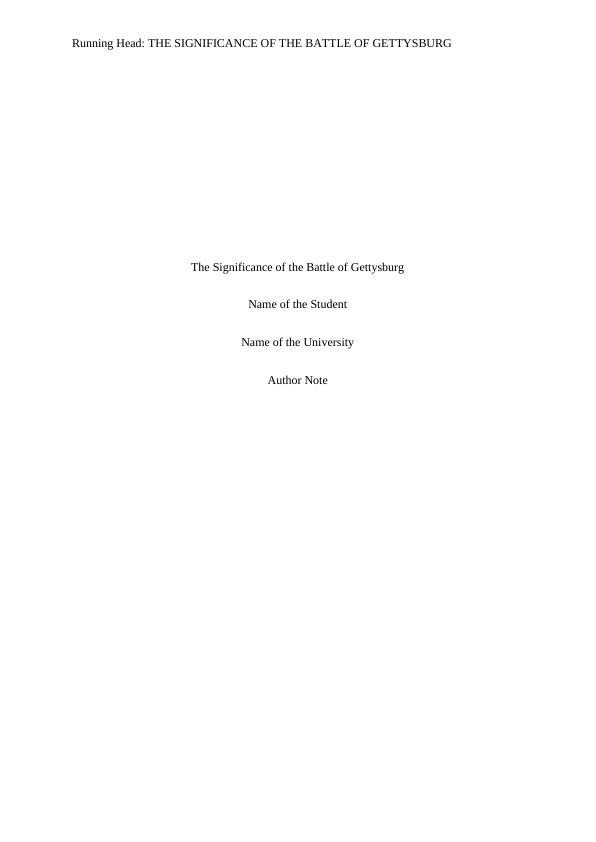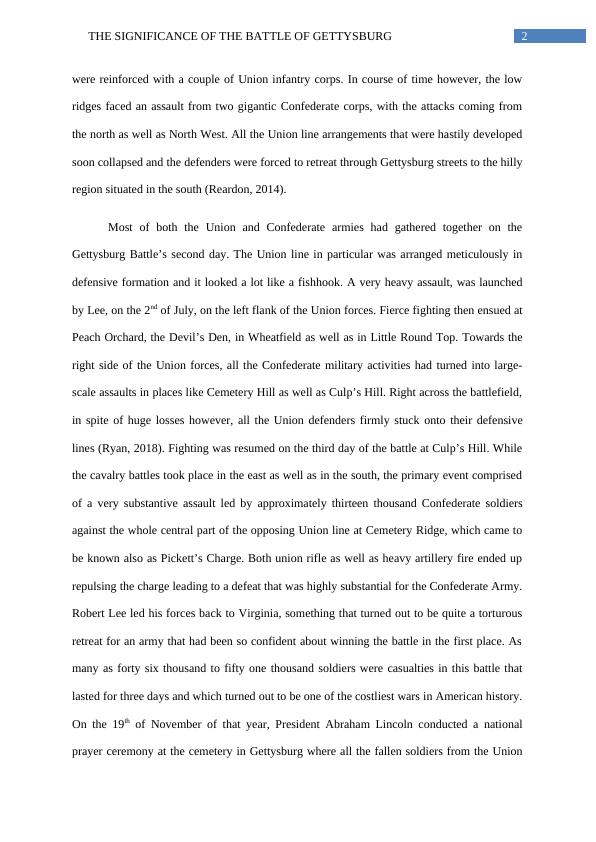The Significance of the Battle of Gettysburg
8 Pages2114 Words85 Views
Added on 2023-06-04
About This Document
This essay analyzes the causes of the Battle of Gettysburg, describes in brief the events that took place during the battle and concludes in analysis that the battle was a turning point in the Civil War, generating massive casualties and signifying the complete destruction of the southern Confederate Army.
The Significance of the Battle of Gettysburg
Added on 2023-06-04
ShareRelated Documents
Running Head: THE SIGNIFICANCE OF THE BATTLE OF GETTYSBURG
The Significance of the Battle of Gettysburg
Name of the Student
Name of the University
Author Note
The Significance of the Battle of Gettysburg
Name of the Student
Name of the University
Author Note

1THE SIGNIFICANCE OF THE BATTLE OF GETTYSBURG
The American Battle of Gettysburg occurred from the 1st to the 3rd of July in 1863, at
a place called Gettysburg, a small town in Pennsylvania. The battle formed an important part
of the North American Civil War and was fought between the Confederate and Union forces,
with the Confederate forces losing out heavily at the end of the conflict (Jordan, 2014). This
essay analyzes the causes of the Battle of Gettysburg, describes in brief the events that took
place during the battle and concludes in analysis that the battle was a turning point in the
Civil War, generating massive casualties and signifying the complete destruction of the
southern Confederate Army.
After experiencing huge success at Chancellorsville, Virginia in the month of May in
1863, General Robert Lee who was heading the Northern Virginia Army guided his forces
through the famous Shenandoah Valley in order to embark on an invasion for the second time
of the North, the campaign this time around being labeled as the Gettysburg Campaign. The
army was in very high spirits and this had a role in motivating Robert Lee enough to change
the entire emphasis of his military campaign from the northern part of Virginia in the hope of
persuading the politicians of the North to surrender and surrender their fight in the Civil War,
by infiltrating right up to Philadelphia and the town of Harrisburg in Pennsylvania (Orr,
2017). Major General Joseph Hooker who was appointed and prodded on by the American
president Abraham Lincoln, moved his forces in pursuit, but however, was made to give up
the command exactly three days prior to the conflict, being substituted by a man called
Meade instead. Both the opposing armies collided against each other initially at the town of
Gettysburg on the 1st of July in 1863. Lee concentrated his forces very urgently over here, as
his primary objective was to enter into an engagement with the opposing United Army and to
consequently, destroy it. The low ridges that were situated in the North-Western part of the
town of Gettysburg were initially defended well enough by the cavalry division of the Union
forces under the leadership of Brigadier General John Buford. Soon enough the low ridges
The American Battle of Gettysburg occurred from the 1st to the 3rd of July in 1863, at
a place called Gettysburg, a small town in Pennsylvania. The battle formed an important part
of the North American Civil War and was fought between the Confederate and Union forces,
with the Confederate forces losing out heavily at the end of the conflict (Jordan, 2014). This
essay analyzes the causes of the Battle of Gettysburg, describes in brief the events that took
place during the battle and concludes in analysis that the battle was a turning point in the
Civil War, generating massive casualties and signifying the complete destruction of the
southern Confederate Army.
After experiencing huge success at Chancellorsville, Virginia in the month of May in
1863, General Robert Lee who was heading the Northern Virginia Army guided his forces
through the famous Shenandoah Valley in order to embark on an invasion for the second time
of the North, the campaign this time around being labeled as the Gettysburg Campaign. The
army was in very high spirits and this had a role in motivating Robert Lee enough to change
the entire emphasis of his military campaign from the northern part of Virginia in the hope of
persuading the politicians of the North to surrender and surrender their fight in the Civil War,
by infiltrating right up to Philadelphia and the town of Harrisburg in Pennsylvania (Orr,
2017). Major General Joseph Hooker who was appointed and prodded on by the American
president Abraham Lincoln, moved his forces in pursuit, but however, was made to give up
the command exactly three days prior to the conflict, being substituted by a man called
Meade instead. Both the opposing armies collided against each other initially at the town of
Gettysburg on the 1st of July in 1863. Lee concentrated his forces very urgently over here, as
his primary objective was to enter into an engagement with the opposing United Army and to
consequently, destroy it. The low ridges that were situated in the North-Western part of the
town of Gettysburg were initially defended well enough by the cavalry division of the Union
forces under the leadership of Brigadier General John Buford. Soon enough the low ridges

2THE SIGNIFICANCE OF THE BATTLE OF GETTYSBURG
were reinforced with a couple of Union infantry corps. In course of time however, the low
ridges faced an assault from two gigantic Confederate corps, with the attacks coming from
the north as well as North West. All the Union line arrangements that were hastily developed
soon collapsed and the defenders were forced to retreat through Gettysburg streets to the hilly
region situated in the south (Reardon, 2014).
Most of both the Union and Confederate armies had gathered together on the
Gettysburg Battle’s second day. The Union line in particular was arranged meticulously in
defensive formation and it looked a lot like a fishhook. A very heavy assault, was launched
by Lee, on the 2nd of July, on the left flank of the Union forces. Fierce fighting then ensued at
Peach Orchard, the Devil’s Den, in Wheatfield as well as in Little Round Top. Towards the
right side of the Union forces, all the Confederate military activities had turned into large-
scale assaults in places like Cemetery Hill as well as Culp’s Hill. Right across the battlefield,
in spite of huge losses however, all the Union defenders firmly stuck onto their defensive
lines (Ryan, 2018). Fighting was resumed on the third day of the battle at Culp’s Hill. While
the cavalry battles took place in the east as well as in the south, the primary event comprised
of a very substantive assault led by approximately thirteen thousand Confederate soldiers
against the whole central part of the opposing Union line at Cemetery Ridge, which came to
be known also as Pickett’s Charge. Both union rifle as well as heavy artillery fire ended up
repulsing the charge leading to a defeat that was highly substantial for the Confederate Army.
Robert Lee led his forces back to Virginia, something that turned out to be quite a torturous
retreat for an army that had been so confident about winning the battle in the first place. As
many as forty six thousand to fifty one thousand soldiers were casualties in this battle that
lasted for three days and which turned out to be one of the costliest wars in American history.
On the 19th of November of that year, President Abraham Lincoln conducted a national
prayer ceremony at the cemetery in Gettysburg where all the fallen soldiers from the Union
were reinforced with a couple of Union infantry corps. In course of time however, the low
ridges faced an assault from two gigantic Confederate corps, with the attacks coming from
the north as well as North West. All the Union line arrangements that were hastily developed
soon collapsed and the defenders were forced to retreat through Gettysburg streets to the hilly
region situated in the south (Reardon, 2014).
Most of both the Union and Confederate armies had gathered together on the
Gettysburg Battle’s second day. The Union line in particular was arranged meticulously in
defensive formation and it looked a lot like a fishhook. A very heavy assault, was launched
by Lee, on the 2nd of July, on the left flank of the Union forces. Fierce fighting then ensued at
Peach Orchard, the Devil’s Den, in Wheatfield as well as in Little Round Top. Towards the
right side of the Union forces, all the Confederate military activities had turned into large-
scale assaults in places like Cemetery Hill as well as Culp’s Hill. Right across the battlefield,
in spite of huge losses however, all the Union defenders firmly stuck onto their defensive
lines (Ryan, 2018). Fighting was resumed on the third day of the battle at Culp’s Hill. While
the cavalry battles took place in the east as well as in the south, the primary event comprised
of a very substantive assault led by approximately thirteen thousand Confederate soldiers
against the whole central part of the opposing Union line at Cemetery Ridge, which came to
be known also as Pickett’s Charge. Both union rifle as well as heavy artillery fire ended up
repulsing the charge leading to a defeat that was highly substantial for the Confederate Army.
Robert Lee led his forces back to Virginia, something that turned out to be quite a torturous
retreat for an army that had been so confident about winning the battle in the first place. As
many as forty six thousand to fifty one thousand soldiers were casualties in this battle that
lasted for three days and which turned out to be one of the costliest wars in American history.
On the 19th of November of that year, President Abraham Lincoln conducted a national
prayer ceremony at the cemetery in Gettysburg where all the fallen soldiers from the Union

End of preview
Want to access all the pages? Upload your documents or become a member.
Related Documents
The Gettysburg Address: Historical and Cultural Significancelg...
|4
|551
|34
American History: Lincoln's Approach vs Radical Republicanslg...
|5
|1075
|296
